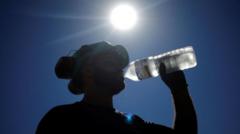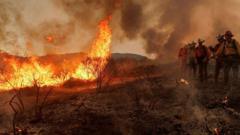In the holy city of Mecca, more than 1.4 million Muslim pilgrims commenced their sacred Hajj pilgrimage today, amid stringent directives to manage the hazards of soaring temperatures which are projected to reach 44°C (111°F). This year's precautions come in response to a heartbreaking report from last year when 1,300 climactic-related deaths occurred, primarily among unregistered pilgrims.
Authorities have taken significant strides in enhancing safety, including the planting of thousands of trees and the installation of hundreds of cooling units throughout the city. The government has also imposed regulations such as banning children under 12 from participating and warning that those caught undertaking the pilgrimage without official permits face hefty fines of $5,000 and a 10-year entry ban. So far, over 269,000 unauthorized individuals have been prevented from entering Mecca.
Many of the deceased in the previous year were unregistered pilgrims, especially from Egypt and Indonesia, who lacked access to essential amenities like air-conditioned accommodations and transportation during extreme heat that reached up to 51°C. Often, those who cannot afford official Hajj packages, which can range from $4,000 to $20,000 depending on various factors, try to enter Saudi Arabia through tourist or visitor visas.
As the first day of the Hajj unfolded, male pilgrims donned two white garments, symbolizing their entry into a state of Ihram, while women wore modest attire. They gathered at the Grand Mosque, the holiest site in Islam, performing the tawaf, a sacred ritual of circling the Kaaba, and then proceeded to Mina for an overnight stay in a massive tent city.
The Saudi health ministry has emphasized the importance of preventive measures to counter the intense heat. Pilgrims are advised to avoid sun exposure between 10:00 AM and 4:00 PM, utilize umbrellas for shade, and stay hydrated. Furthermore, shaded areas have been expanded by 50,000 square meters, and over 400 cooling units have been installed to assist in temperature management.
The Grand Mosque is equipped with the world's largest cooling system, and newly constructed rubberized, cooled roads are anticipated to lower surface temperatures. The crowd management also incorporates AI technology to monitor drone fleets effectively.
In 2015, a calamitous stampede in Mina claimed over 2,300 lives, marking a tragic history of safety concerns associated with the Hajj pilgrimage. This year, amidst renewed fervor and solemnity, authorities remain vigilant in their efforts to ensure the safety and well-being of all pilgrims.
Authorities have taken significant strides in enhancing safety, including the planting of thousands of trees and the installation of hundreds of cooling units throughout the city. The government has also imposed regulations such as banning children under 12 from participating and warning that those caught undertaking the pilgrimage without official permits face hefty fines of $5,000 and a 10-year entry ban. So far, over 269,000 unauthorized individuals have been prevented from entering Mecca.
Many of the deceased in the previous year were unregistered pilgrims, especially from Egypt and Indonesia, who lacked access to essential amenities like air-conditioned accommodations and transportation during extreme heat that reached up to 51°C. Often, those who cannot afford official Hajj packages, which can range from $4,000 to $20,000 depending on various factors, try to enter Saudi Arabia through tourist or visitor visas.
As the first day of the Hajj unfolded, male pilgrims donned two white garments, symbolizing their entry into a state of Ihram, while women wore modest attire. They gathered at the Grand Mosque, the holiest site in Islam, performing the tawaf, a sacred ritual of circling the Kaaba, and then proceeded to Mina for an overnight stay in a massive tent city.
The Saudi health ministry has emphasized the importance of preventive measures to counter the intense heat. Pilgrims are advised to avoid sun exposure between 10:00 AM and 4:00 PM, utilize umbrellas for shade, and stay hydrated. Furthermore, shaded areas have been expanded by 50,000 square meters, and over 400 cooling units have been installed to assist in temperature management.
The Grand Mosque is equipped with the world's largest cooling system, and newly constructed rubberized, cooled roads are anticipated to lower surface temperatures. The crowd management also incorporates AI technology to monitor drone fleets effectively.
In 2015, a calamitous stampede in Mina claimed over 2,300 lives, marking a tragic history of safety concerns associated with the Hajj pilgrimage. This year, amidst renewed fervor and solemnity, authorities remain vigilant in their efforts to ensure the safety and well-being of all pilgrims.





















